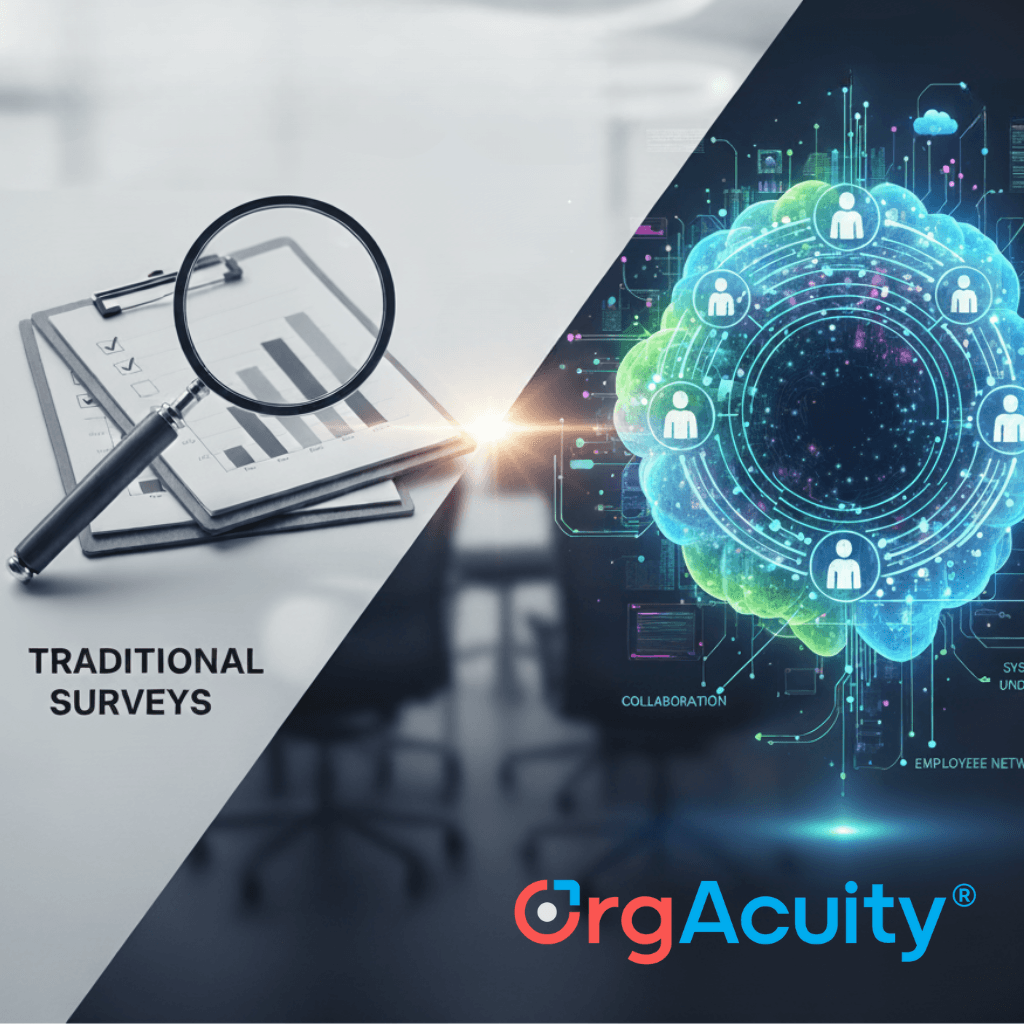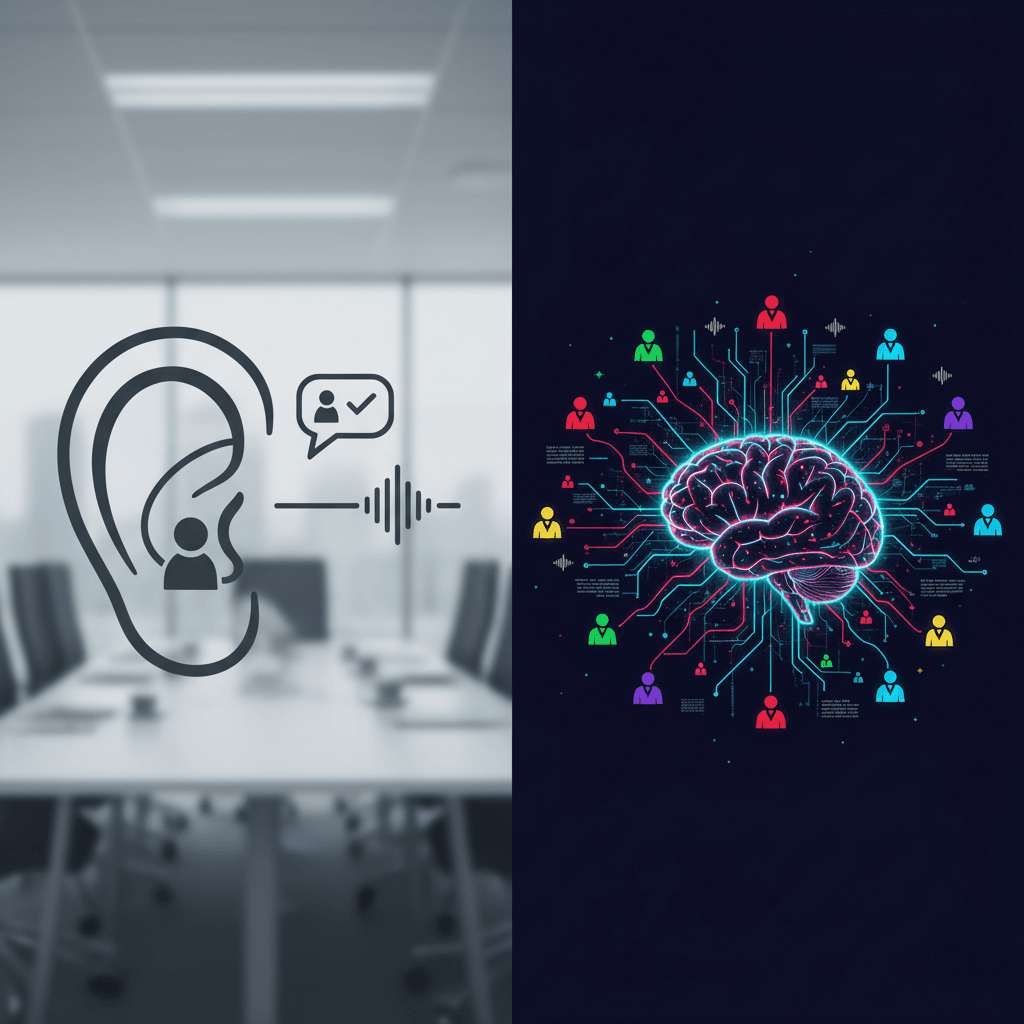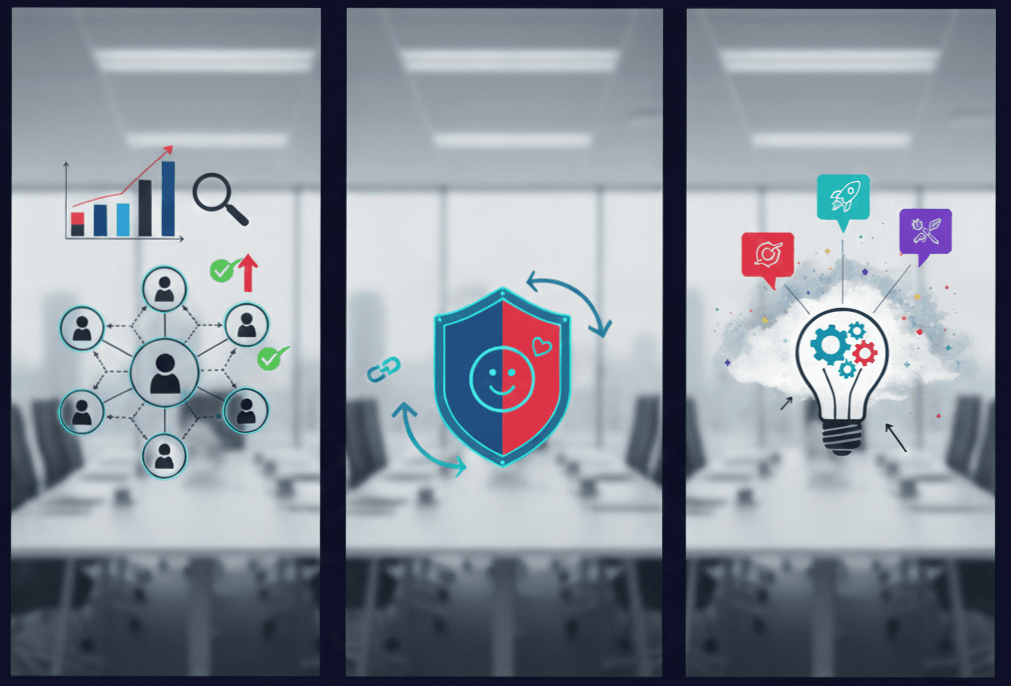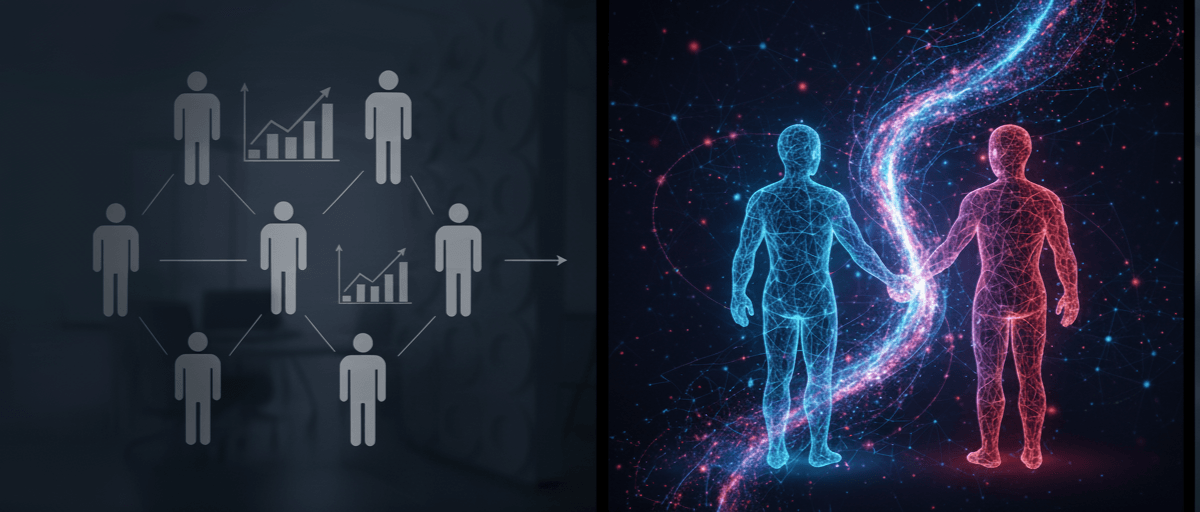If You Already Have Surveys… Why Add OrgAcuity?

(Short answer: Relationships)
Over the last decade in and around HR SaaS, I’ve watched the same pattern repeat. Buyer preferences swing from all-in-one HRIS suites to specialized tools and then back again. With every swing, a familiar chorus inside vendors steps forward to explain why the market is shifting. Roadmaps adjust. Products expand or fragment. New offerings appear while old ones get repackaged.
The real question I’ve learned to ask in those moments is simple: Are we separating signal from noise? What we hear depends on what we’re listening for and why we’re listening in the first place. Those answers quietly shape products, implementation choices, and outcomes.
In times of uncertainty, the all-in-one option can feel like the safe bet. But “safe” and “right” aren’t always the same. Every choice comes with trade-offs. The decision you’re really making is this: Do you want to check the box “we capture employee feedback and sentiment,” or do you want that and a deeper understanding of how work actually gets done, with relationship insights that surface the patterns behind results?
So when leaders ask, “We already run engagement surveys and track everything in the HRIS, why add OrgAcuity?” it’s a fair question. Our short answer never changes: relationships. Not “office friendships,” but the invisible web where work truly happens, who influences whom, where information flows or stalls, and how collaboration patterns shape engagement, performance, and retention. That’s the missing context most tools can’t see.
What does that mean in practice? Let’s unpack it.
Valuing the Tools You Already Have
First, some appreciation for the stack you’ve built. This is an “and,” not an “or.”
What your HRIS is great for (the What)
Think of the HRIS as your organizational blueprint and source of truth for the formal structure: roles, reporting lines, tenure, locations. If you ask, “What’s happening?” the HRIS answers. For example, it tells you engineering had 15% turnover last quarter. That is critical. It is non-negotiable; your HRIS is essential.
What your surveys are great for (the How)
Surveys are snapshots of lived experience in a moment. They answer, “How are people experiencing work right now?” They are invaluable for gauging clarity, resources, burnout, and manager support.
Maybe your last survey says 70% of engineers feel under-resourced. That is how they feel. Done well, surveys deliver business value. When organizations listen and act, outcomes improve. When employees see no action, fatigue sets in. The difference isn’t survey frequency. It’s follow-through and impact.
Enhance Your Employee Listening (the Why and the Who)

This is where relationships come in and where OrgAcuity focuses. We are not tracking who eats lunch together. We are mapping the living network: influence, trust, mentorship, knowledge hubs, and the communities where change either spreads or stalls.
HRIS sets the formal structure and supports core HR functions.
Surveys capture experience and sentiment.
OrgAcuity captures experience and sentiment and surfaces the underlying connections and flows that impact outcomes.
OrgAcuity helps you see the central nervous system of the organization: where collaboration happens, who is carrying too much load, and which relationships enable or block performance. It is network-based employee listening that integrates experience feedback with organizational network analysis (ONA) to reveal influencers, hidden communities, and collaboration patterns that shape culture, execution, and results. And yes, it all runs through surveys. No spyware. No calendar or email taps.
Back to that Engineering Example
The HRIS told you what: 15% turnover.
The survey told you how people feel: 70% “under-resourced.”
Network-based listening adds the why and who: perhaps the three most influential engineers, the ones everyone goes to for advice, are isolated and overloaded, bottlenecking information. Or the leavers were all connected to a single manager who didn’t show up in top-line results. Now you have a starting point for action, not just another dashboard tile.
Why This Matters: Three Fast, Concrete Use Cases

1) Change Management That Actually Moves
Surveys show 40% of employees feel anxious about the new CRM. Helpful. But who shapes that anxiety day to day? Network-based listening identifies the key influencers most skeptical of the rollout and the people everyone trusts for systems advice. Now you know precisely whom to engage, equip, and turn into early champions. Addressing resistance early within the change management process is essential to rolling out a successful approach to change in any organization.
2) Onboarding & Ramp Speed: Get New Hires Into the Flow of Work
Your HRIS captures and stores key employee data on new hires. Surveys add that new teammates report a lack of clarity on who to ask for help or how decisions get made. Network insights reveal why this may be the case and who these people are. Many new hires sit at the edge of collaboration networks, connected to their manager but not to the day-to-day advice givers. Targeted actions, buddy pairings with the right connectors, structured cross-team introductions, and early project rotations pull people into the center of work, where they learn how work gets accomplished.
3) Spotting Hidden High-Potentials and Flight Risks
Performance data often misses the quiet contributors who field questions from multiple departments. Network-based listening surfaces these go-to connectors, brokers, and culture carriers early so you can invest before attrition risk spikes. When people feel heard, supported, and given recognition, retention and performance improve.
Turning Insight Into Action (Without Burning People Out)
In most listening programs, data capture isn’t the bottleneck. Putting results into action is. The number-one driver of “survey fatigue” is a lack of visible action on feedback. Organizations that listen and close the loop see higher participation and better engagement. Frequency alone isn’t the lever. Follow-through is.
Collaboration patterns also show a small fraction of people often carry disproportionate collaborative loads, a recipe for burnout and stalled execution. Rob Cross shared in his book Beyond Collaboration Overload: just 3-5% of employees account for 20-35% of all value-adding collaborations. That turns helpful high-performers into bottlenecks and puts them at risk of burnout. The goal isn’t to glorify heroics from over-connectors. It is to rebalance the load, protect those hubs, and redesign workflows so knowledge moves without grinding down the same few people. Network-based listening makes those imbalances visible, so you can spread work, strengthen bridges, and keep progress sustainable.
Why Relationships Are a Performance Multiplier

Performance and innovation. Teams high in psychological safety and trust learn faster and generate more and better ideas. People who bridge across groups access novel information and perspectives that improve problem solving.
Decision speed. Trust accelerates coordination. When people trust each other, decisions move without endless second-guessing. Problems surface earlier and get resolved faster.
Engagement and retention. When people feel heard and see action, engagement strengthens. Strong ties to managers and cross-functional partners shape day-to-day experience, development, and support.
The quality of our relationships is tightly linked to well-being. Relationships are the connective tissue of organizational life.
Okay, But How Does This Work (Simply)?
The fastest, least-creepy, and most direct path is survey-based ONA (active ONA): a small set of targeted questions that reveal who people turn to for advice, development, problem solving, and support. Paired with standard listening items, you can:
Identify influencers by type: Advisors, Mentors, SMEs, Culture Carriers, Support Anchors.
See network health: Cohesion, bridges, isolates, overload.
Map manager impact: Are managers named by their teams in influence questions?
Prioritize action: which relationships, teams, and hubs will create outsized gains if strengthened.
A pattern we see consistently: when a manager isn’t named by any direct reports across these influence questions, team-level outcomes tend to lag. When they are named, scores on items like feedback quality and career growth are meaningfully higher. The manager still matters, just in a networked, enablement-first way.
What OrgAcuity Adds (And Why It Complements, Not Replaces)
OrgAcuity is built to make advanced people analytics accessible, especially for organizations without large analytics teams. The platform unifies employee listening with ONA, turning scattered inputs into integrated, narrative-ready insight and then into prescriptive, practical action. Instead of dumping “best-practice action libraries” on managers, it generates tailored guidance based on the real signals and dynamics of each team.
Integrated Listening + ONA. Combine experience data with relationship patterns to see not just sentiment, but how work actually moves.
Curated narratives and prescriptive actions. People don’t act on raw dashboards. They act on clear stories with concrete next steps.
Speed to value. Simple implementation and a modern, intuitive UX so you’re acting in weeks, not quarters.
Differentiators that matter. From multi-item engagement scales that preserve comparability to unique participation insights and alerts, we focus on details that lead to better decisions.
It’s an “And,” Not an “Or”
HRIS is your blueprint. You need it for structure (“the what”). Surveys are your snapshots. You need them for structure and core HR functions (“the how”). OrgAcuity provides the snapshot and maps out the informal relationships that explain why and who, so you can act with precision.
Listening programs don’t fail because they ask too many questions. They fail when they ask without acting. Action sticks when you work with the network, strengthen trust, mobilize brokers and carriers, and pull in people left at the edges of collaboration.
The question isn’t whether you need more data; it is whether you have the right context to act on it. If you could finally see the connections behind the numbers, what would you choose to change first? Which overloaded hubs would you protect, and where would you build bridges next? If you had clear line-of-sight to your hidden influencers, how would that reshape your next change, onboarding plan, or retention bet?
For more insight on the importance of relationships checkout this article -> https://orgacuity.com/blog/the-hidden-infrastructure-behind-performance/